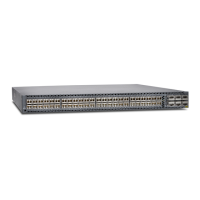other side of the chassis. This configuration provides the commonly deployed A/B
feed redundancy for the system.
To connect the power supply to the power source:
a. Secure the ring lug of the positive (+) DC power source cable to the V+ terminal
on the DC power supply.
b. Secure the ring lug of the negative (–) DC power source cable to the V– terminal
on the DC power supply.
c. Tighten the screws on the power supply terminals until they are snug by using the
screwdriver. Do not overtighten—apply between 5 lb-in (0.56 Nm) and 6 lb-in
(0.68 Nm) of torque to the screws.
8. Replace the terminal block cover.
9. Close the input circuit breaker.
10. Verify that the DC LEDs are lit green and on steadily.
Step 5: Perform Initial Software Configuration
This procedure connects the router to the network but does not enable it to forward
traffic. For complete information about configuring the router to forward traffic, including
examples, see the Junos OS configuration guides.
You must perform the initial configuration of the router through the console port. Before
you begin, set the following parameter values in the console server or PC:
•
Baud Rate—9600
•
Flow Control—None
•
Data—8
•
Parity—None
•
Stop Bits—1
•
DCD State—Disregard
To connect and configure the router from the console:
1. Connect the console port to a laptop or PC by using the provided RJ-45 cable and
RJ-45 to DB-9 serial port adapter. The console (CON) port is located on the
management panel of the router.
2. Log in as root. There is no password. If the software boots before you connect to the
console port, you might need to press the Enter key for the prompt to appear.
login: root
3. Start the command-line interface (CLI).
root@% cli
4. Enter configuration mode.
9Copyright © 2015, Juniper Networks, Inc.
Step 5: Perform Initial Software Configuration

